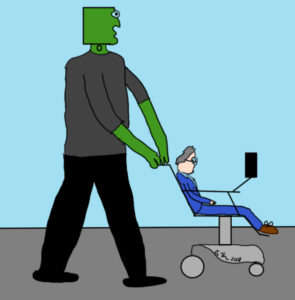by Jonathan D. Moreno, Ph.D.
If Stephen Hawking knew that he was facing his last days he would surely have been amused that his death would come on Albert Einstein’s birthday and almost exactly two hundred years after the publication of Mary Shelley’s Frankenstein. As a matter of character and reputation the imaginary Victor and the richly real Stephen couldn’t have been more different, but together they represent our Janus-Headed modern view of science and scientists.
Hawking was the bright, shining face of creative genius and human intellectual flourishing, gifted with both an immense imagination and a startling, vulnerable humanity. He was no less an explorer than Christopher Columbus or John Glenn, but his exploration came in the most human way possible, through his mind rather than mere physical mobility. Both in his life and in the way he was experienced by his adoring public Hawking was a man tethered to technology. Between his wheelchair and his trademark mechanical voice (which he finally embraced despite regrets about the American accent), he qualified as a cyborg, “more machine than man” in one admirer’s observation.

Hawking and Victor Frankenstein will always be tied to technology in our collective memory. Dr. Frankenstein’s galvanized, reanimated, stitched-up creature is often defended as an innocent victim who didn’t ask to be born. Perhaps unable to accept ultimate responsibility for his hubris, Victor Frankenstein came to have his own doubts about his project and his fiendish progeny, but as far as posterity was concerned it was too late. His creature was out of the lab and into the streets, and –through innumerable plays, novels, movies and nightmares — forever in our heads. My mother, after she saw the 1931 film at the age of 16 in a dark and dreary London, remembered walking home alone in utter terror.
Who can imagine the once-belittled, now mainstream genre called science fiction without Frankenstein? And who, as well, can think about science and scientists without their creations and ambitions? The very words were only emerging in their modern senses in the early 19th century. Victor’s shadow hung over real electromagnetic investigators like the celebrated Michael Faraday and fictional dual personalities of Dr. Jekyll and Mr. Hyde. Though Jekyll was another power-mad scientist Thomas Edison was just mad for (electrical) power. A year after Robert Louis Stevenson’s novel was published Edison’s Pearl Street generator provided electricity to a few dozen Manhattan residents. Many more would follow. Life was to be electrified after all.
By the late 19th century a pattern had been established: the fictional God-player versus the real-life popular hero. Between Edison and Hawking the most beloved figure associated with science and technology was Einstein. Like Hawking, the image of Einstein was possessed of certain physical characteristics that fascinated: the wild eyes and unruly grey main. They also shared an appreciation of their public appeal and weren’t reluctant to play to it. It helped that they were both theorists, not experimenters and certainly not biologists. Applied physics and biology lean over to Promethean territory with all its moral complexities.
Not that they didn’t have grave doubts about the human future despite the ironies of their respective positions. Einstein’s last public act was to join an anti-nuclear manifesto though he was a crucial advocate for what became the Manhattan Project. And Hawking lent his synthesized speaking voice to warnings about artificial intelligence run amuck. Yet somehow their ambiguous roles lent them even more credibility.
The misbegotten arrogant scientists of our anxious imaginings don’t hold a candle to the real ones who illuminate our universe. Hawking reminded us that in the real world a fiction can enrich our moral narratives but in the end we have to write our own.